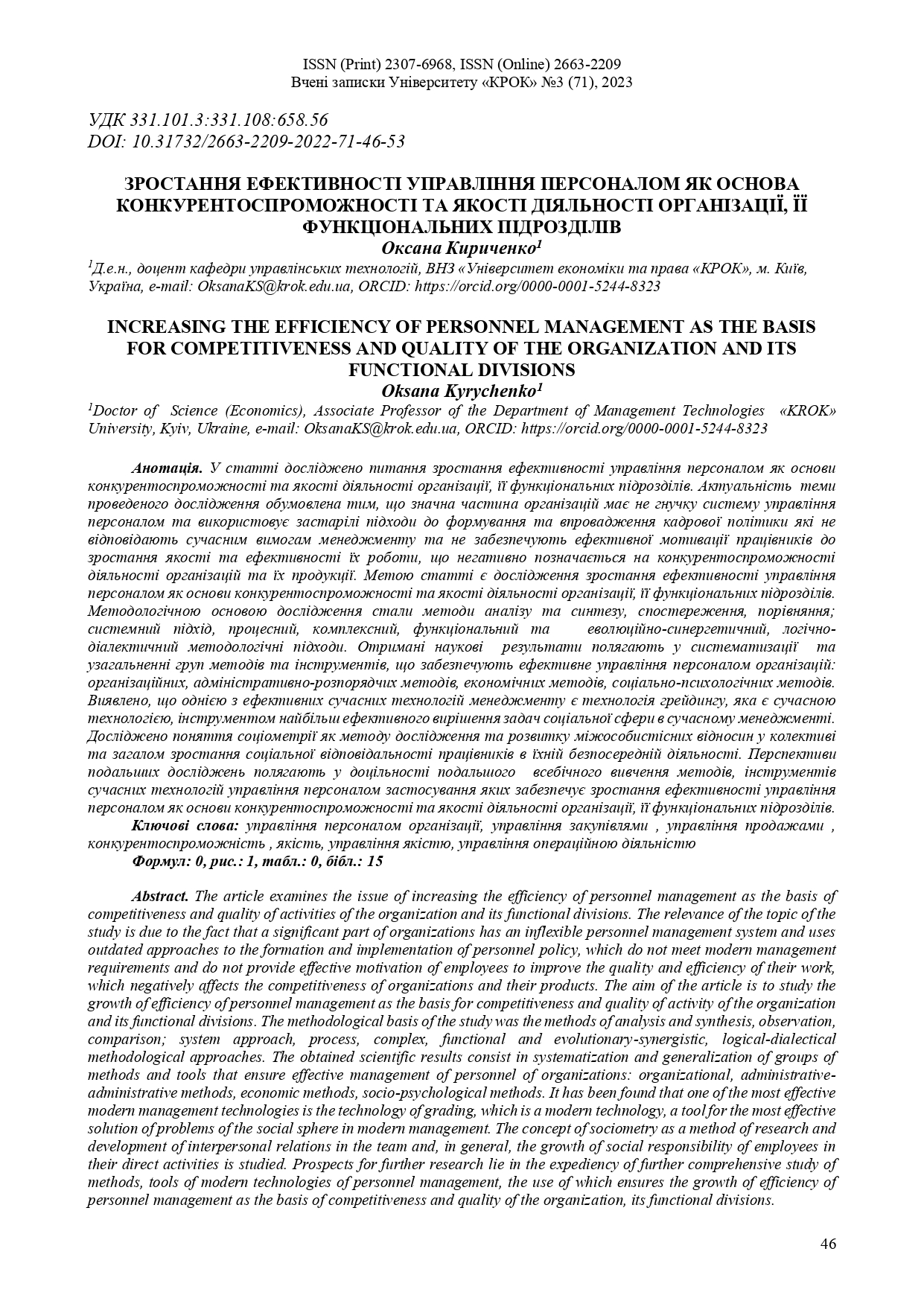INCREASING THE EFFICIENCY OF PERSONNEL MANAGEMENT AS THE BASIS FOR COMPETITIVENESS AND QUALITY OF THE ORGANIZATION AND ITS FUNCTIONAL DIVISIONS
DOI:
https://doi.org/10.31732/2663-2209-2022-71-46-53Keywords:
Organization Human Resources Management, Procurement Management, Sales Management, Quality, Quality Management, Competitiveness, Operations ManagementAbstract
The article examines the issue of increasing the efficiency of personnel management as the basis of competitiveness and quality of activities of the organization and its functional divisions. The relevance of the topic of the study is due to the fact that a significant part of organizations has an inflexible personnel management system and uses outdated approaches to the formation and implementation of personnel policy, which do not meet modern management requirements and do not provide effective motivation of employees to improve the quality and efficiency of their work, which negatively affects the competitiveness of organizations and their products. The aim of the article is to study the growth of efficiency of personnel management as the basis for competitiveness and quality of activity of the organization and its functional divisions. The methodological basis of the study was the methods of analysis and synthesis, observation, comparison; system approach, process, complex, functional and evolutionary-synergistic, logical-dialectical methodological approaches. The obtained scientific results consist in systematization and generalization of groups of methods and tools that ensure effective management of personnel of organizations: organizational, administrative-administrative methods, economic methods, socio-psychological methods. It has been found that one of the most effective modern management technologies is the technology of grading, which is a modern technology, a tool for the most effective solution of problems of the social sphere in modern management. The concept of sociometry as a method of research and development of interpersonal relations in the team and, in general, the growth of social responsibility of employees in their direct activities is studied. Prospects for further research lie in the expediency of further comprehensive study of methods, tools of modern technologies of personnel management, the use of which ensures the growth of efficiency of personnel management as the basis of competitiveness and quality of the organization, its functional divisions.
Downloads
References
Armstrong,M. (2006). A Handbook of Human Resource Management Practice. 10 th Edition, Kogan Page Publishing, London. English.
Данюк В.М. (2013) Управління персоналом. К.: КНЕУ. 666 с.
Рульєв. В.А., Гуткевич С.О., Мостенська Т.Л. (2012). Управління персоналом. К.: КОНДОР. 324 с.
Балабанова Л.В., Стельмашенко О.В. (2010). Стратегічне управління персоналом підприємства в умовах ринкової економіки: монографія. Донецьк: ДонНУЕТ. 238 с.
Крушельницька О.В., Мельничук Д.П. (2003). Управління персоналом. К.: Кондор. 296 с.
Кириченко О.С. (2021). Інвестиційно-інноваційне забезпечення промисловості України в умовах Четвертої промислової революції: монографія. К.: Університет економіки та права «КРОК». 368 с.
Davis K. (1957). Human Relations in Business N. Y. English.
Drucker P. (1985). Innovation and Entrepreneurship: Practict and Principles. Nev York: Harper and Row Publishes, English.
Graham, H. T. & Bennett. R. (1995). Human resources management: Print Book, English.
Збрицька Т. П. (2012). Система участі працівників у прибутках як один з методів мотивації. Технічний прогрес і ефективність виробництва. № 15. С. 104–109
Іванова І. В. (2006). Професіоналізація менеджменту: монографія. Київ : Київ. нац. торг.-екон. ун-т. 695 с.
Ігумнов Б. М. (2001). Моделі для організації самоспостережень у нормування праці: монографія. Хмельницький: Еврика. 236 с.
Pеnc J. (2000). Kreatywne kierowanie.Warszawa: Agencja wydawnicza «Placet», Poland
Morin J. (1989) Le management des ressources technologiques. Paris : Les editions d organization, French
Narayanan V.K. (2000) Managing technology and innovation for competitive advantage. Cambridge, MA: Harvard Business School Publishing, English.

Downloads
Published
How to Cite
Issue
Section
License

This work is licensed under a Creative Commons Attribution-NonCommercial 4.0 International License.

